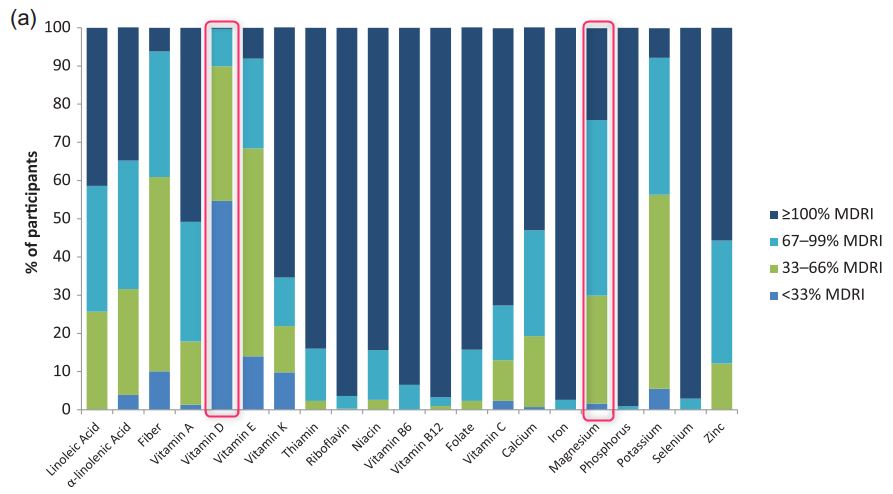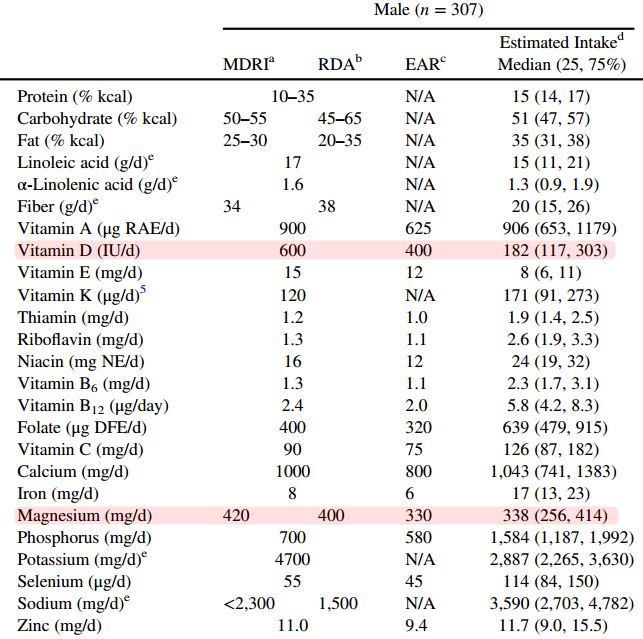No military trainee consumed Vitamin D RDA (most were also low in Magnesium)
Dietary Intake in Relation to Military Dietary Reference Values During Army Basic Combat Training; a Multi-center, Cross-sectional Study.
Mil Med. 2018 Jul 3. doi: 10.1093/milmed/usy153. [Epub ahead of print]
Lutz LJ1, Gaffney-Stomberg E1, Karl JP1, Hughes JM1, Guerriere KI1, McClung JP1.


📄 Download the PDF from VitaminDWiki
INTRODUCTION:
The military dietary reference intakes (MDRIs), outlined in Army Regulation 40-25, OPNAVINST 10110.1/MCO10110.49, AFI 44-141, establish standards intended to meet the nutrient requirements of Warfighters. Therefore, the purpose of this study was to comprehensively compare the revised MDRIs, published in 2017, with estimated dietary intakes in U.S. military personnel.
MATERIALS AND METHODS:
During this cross-sectional study, Block food frequency questionnaires were administered at the end of the 9-week basic combat training course to estimate dietary intake during basic combat training in male (n = 307) and female (n = 280) recruits. The cut-point method was used to determine nutrient adequacy in comparison to the MDRIs. This study was approved by the Institutional Review Board of the U.S. Army Research Institute of Environmental Medicine.
RESULTS:
Recruits consumed an adequate amount of vitamins A, C and K, as well as the B-vitamins, and phosphorus, selenium, zinc, and protein and carbohydrate as a percentage of total calories when compared with MDRI standards. Vitamin D was the short-fall nutrient affecting the greatest number of participants, as 55 and 70% of males and females, respectively, consumed less than 33% of the MDRI. In addition, less than 50% of males met the MDRI for linoleic and α-linolenic acid, fiber, vitamin E, magnesium, and potassium, and less than 50% of females met the MDRI for α-linolenic acid, fiber, vitamin E, calcium, iron, magnesium, and potassium. In contrast, fat and sodium were over-consumed by both males (78 and 87%, respectively) and females (73 and 72%, respectively).
CONCLUSION:
The main findings of this study were that vitamins D and E, magnesium, potassium, α-linolenic acid, and fiber were under consumed by male and female recruits while males also did not consume adequate linoleic acid and females did not consume adequate calcium and iron. Future prospective research studies are needed to determine possible health and performance impacts that may be associated with suboptimal intake of these nutrients.
